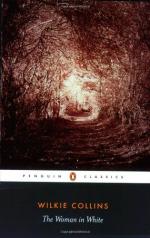We were close to the churchyard when she spoke. The church, a dreary building of grey stone, was situated in a little valley, so as to be sheltered from the bleak winds blowing over the moorland all round it. The burial-ground advanced, from the side of the church, a little way up the slope of the hill. It was surrounded by a rough, low stone wall, and was bare and open to the sky, except at one extremity, where a brook trickled down the stony hill-side, and a clump of dwarf trees threw their narrow shadows over the short, meagre grass. Just beyond the brook and the trees, and not far from one of the three stone stiles which afforded entrance, at various points, to the church-yard, rose the white marble cross that distinguished Mrs. Fairlie’s grave from the humbler monuments scattered about it.
“I need go no farther with you,” said Miss Halcombe, pointing to the grave. “You will let me know if you find anything to confirm the idea you have just mentioned to me. Let us meet again at the house.”
She left me. I descended at once to the churchyard, and crossed the stile which led directly to Mrs. Fairlie’s grave.
The grass about it was too short, and the ground too hard, to show any marks of footsteps. Disappointed thus far, I next looked attentively at the cross, and at the square block of marble below it, on which the inscription was cut.
The natural whiteness of the cross was a little clouded, here and there, by weather stains, and rather more than one half of the square block beneath it, on the side which bore the inscription, was in the same condition. The other half, however, attracted my attention at once by its singular freedom from stain or impurity of any kind. I looked closer, and saw that it had been cleaned— recently cleaned, in a downward direction from top to bottom. The boundary line between the part that had been cleaned and the part that had not was traceable wherever the inscription left a blank space of marble—sharply traceable as a line that had been produced by artificial means. Who had begun the cleansing of the marble, and who had left it unfinished?
I looked about me, wondering how the question was to be solved. No sign of a habitation could be discerned from the point at which I was standing—the burial-ground was left in the lonely possession of the dead. I returned to the church, and walked round it till I came to the back of the building; then crossed the boundary wall beyond, by another of the stone stiles, and found myself at the head of a path leading down into a deserted stone quarry. Against one side of the quarry a little two-room cottage was built, and just outside the door an old woman was engaged in washing.




